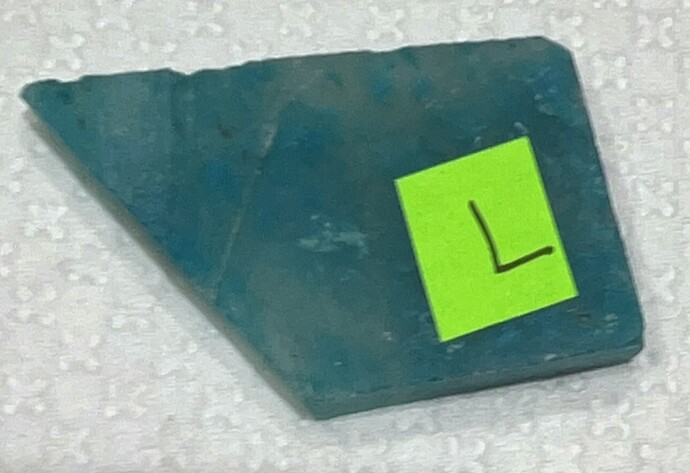I am searching for answers. I would like to know if anyone has some sort of grading scale for Chrysocolla. I am reading a lot but hard to understand quality without something to compair with. Also pricing, where do you start. I am familiar with rubies, diamonds, emarlds :etc but this type of stone I am not understanding. Any help would be appreciated. I have pictures of you would like to see what I have. Thank you Troy
have you found anymore about it? I would like to know about this also. Turquoise is very hard to price also. different grades of turquoise come from the same mine.
What I have found out is that most people put a price on a stone that they thought would closely compare with a stone they saw online. I was told that there is no real comparison chart, its just what you feel it might be. Still searching though.
that’s how most people do it… I haven’t found a way that professionals rate and price thier stones. Chysocolla isn’t as expensive as turquoise but stones that are well colored and hard enough to cab and take a high polish are hard to find. Online prices are all over the place. Lots of online stuff is junk. Some of the cheap good looking material is stabilized.
Turquoise is hard to value also. Turquoise is rarer as it’s an aluminophosphate.versus chrysocolla being an aluminosilicate, although both are found along with malachite and azurite in the supergene oxidized zone of porphyry copper deposits. I suspect that since this is high grade copper ore, much of it is strip mined and crushed indiscriminately at the big commerical copper mines. Turquoise only forms when phosphate is present and not all porphyry copper has phosphate, making it rarer. .
The stuff online is often stablized turquoise, but I also suspect that many of the sellers do not disclose that. I suspect that the same is true for chrysocolla. How to stablize soft crumbly stones at home is using diluted epoxy resin is online. I have a quart bottle full of tumble polished stabilized turquoise that is no good for jewerly making… any exposure to heat will cause the epoxy to burn…it can be drilled to string as a necklace and it’s about all that it can be made into. Needless to say I bought it for dirt cheap… Etsy is one of the worst places for buying and selling… sellers either don’t disclose or don’t know what they are really selling.
I have been told the best place to sell my stones is on Etsy, interested to know how you feel about Etsy. Where do you think the best place to sell these products is at? I would like to find a jeweler/designer to sell to or a lapidary to sell the finished and rough to. I have pictures I will download them and send them to you.

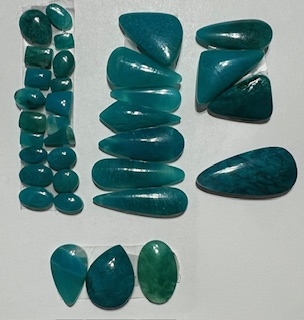
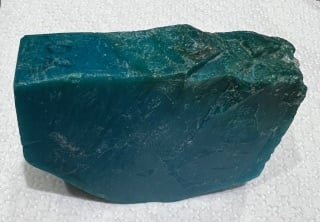
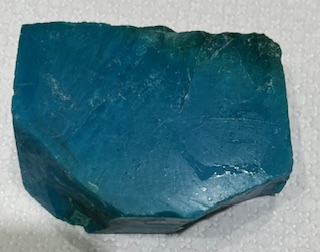

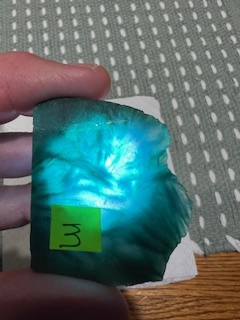
Thanks
royjohn is a professional gem dealer. He’s on this website from time to time. He wrote someone else where to look who had your same question except for different stones… You might want to contact him thru this website. He really doesn’t like Etsy either. While I was researching ruby inclusions, an Etsy site selling rubies popped up… not something that I specifically looking for, but I looked at it just out of curiosity. Not a single seller said whether they were natural or synthetic. The color of at lot of what was being sold as rubies, were pink to orange/yellow sapphires. Prices were all over the place. If it’s really cheap it can’t be natural. Supercheap could be a simulant…synthetic hydrothermal stones cost a fair amount, due to the time and conditions that it requires to grow one. On Etsy, it’s the same thing for turquoise. no statement of being stabilized or untreated.
The stuff you have looks hard and untreated but it’s a little too green… more blue would be better. I have just one tumble polished chrysocolla stone that was given to me by a jeweler when I was a small kid… it’s a vivid blue with some greener patches…I set it into a beaded necklace as a pendant. He gave me a few other stones. At that time, years ago, they were considered cheap semiprecious stones. The quality of the stones that I have collected from years ago are much better overall than what is being sold on line. I regret selling some the jewelry that I made using those high quality stones…but I did keep the necklace/pendant with the jadeite stones that were also given to me… what was low quality jade back then is good quality now.
As far as I know these stones are all stabilized, my brother was a jewelry manufacturer for many years and he used this rough make finished stones for his jewelry. Before he passed away he told us these rocks are gem silica/chrysocolla and he also gave us the name of the person he used to stabilize the rock. Now I am trying to find out what to do with it.
If I;m not wrong pure chrysocolla is soft and crumbly, hardness 2.5 -3… gem varieties have quartz as chalcedony or microcystalline silica that gives it hardness. These can be quite valuable. I don’t know how much of the market is stabilized, but I suspect a large portion as the natural mineral is so soft. High quality gem silica chrysocolla should not have to be stabilized. Stabilization iwould detract from some of the value. If you want to sell it, thre are some online auctions that you can go to. The ultimate value of anything is what a buyer is willing to pay and what the seller is willing to sell at, at the time of sale… I have the same problem with my unset stones that I will eventually need to get rid of. I don’t make jewelry anymore and everything will eventually have to go. Most of my stones were purchased years ago for cheap…, only a few have appreciated ten fold…These I might hang on to as it’s a store of value that is inflation proof… however, eventually they will need to be sold for whatever price I can get.
Hi Steve and Troy, Steve is pretty accurate with regard to Gem Silica (He knows his stuff!). Gem silica would not be stabilized (no need) as it is silicified chrysocolla. Good gem silica will also be translucent. Your photos do look like it could be gem silica. I have come across what some vendors call silica chrysocolla that seems to be material that is a mix of gem silica and softer non or (less?) silicified material.
I have seen pricey material ranging from greenish to blue with (in my opinion) the prettiest and most valuable being blue with good translucency. Prices I have paid and /or seen range from around $10 to $40 per gram rough (sometimes more). For finished cabs, range is maybe $30-$50 per ct with high quality stones being much pricier ($100 plus per ct). I am not a professional either, but FWIW this is just what i have seen at shows. Gem silica seems to becoming pretty popular along with other material such as gaspeite.
Troy said that it was stabilized. I thought from the pictures that it was hard and unstabilized. If it is really stabilized, the price would be lower. If it is gem silica, then it would be a lot more valuable. Nice to see you again Darren.
well said. Now the question is whether it’s stabilized or not.
I’m confused about the stabilization issue. If it’s gem silica, it won’t have to be stabilized. You mentioned that it was stabilized. Darren who contributed to this discussion, gave a price range that is useful. If it is untreated and hard silicified gem chrysocolla, the price would be upper end, except for the color. If it were treated with stabilization, that would detract from the value. Stabilization is mostly done with resins. The most common being epoxy. Some other treatments use sodium silicate which is harder to detect. Any epoxy stabilized stone can be tested easily enough… take an unfolded paper clip and heat it with a torch or on the stove until the tip is bright red hot and touch it to an inconspictous place on the rough… expoxy resins will burn and leave a black mark…what is sacrficed is minimal. Testing for sodium silicate is much more difficult as you will have to test for sodium… sodium is everywhere and could be present in a natural mineral in trace amounts. sodium flame testing is quite sensitive but the wire that you use has to be nichrome or stainless steel…You have to test the wire first by heating it in a torch flame…if the color changes from blue to yellow, sodium is present on or in the wire… it has to be burned off until the flame returns to blue. a grain of rock can be put on a small loop of wire and heated for yellow. If it turns the flame yellow, all you know is that sodium is present. It won’t tell you whether the rock has it or whether it was added with sodium silicate treatment. If the flame doesn’t turn yellow, you know that no sodium is present. These are just DYI screening tests. If you don’t burn a spot on the stone, then it’s unlikely that it was stabilized with resins. If you don’t get a yellow flame, you know that sodium is not present. another DYI test is just sratch hardness. Silica stones will scratch glass like quartz does…for silica stones, the exception is opal. You can narrow down the possibilies by DYI tests…otherwise it would have to be examined by a gemologist experienced in opaque stones… pictures really don’t tell anyone a whole lot…
one more DIY test tip to add at the risk of community lashback! if it were untreated chrysocolla, it will grab at your tongue with a “lick” test. Stabilized or if GS, it would not. The third pic down from top “looks” like it has a run of resin but that could just be shadow. Otherwise, based on the last picture, it does “look” like GS because of the translucency. And, your specimens look very similar to some untreated GS material that I have. I would bet even money that the Hot Needle test will let you know as most common stabilizer is resin - Cactus Juice (type) or opticon - for the “turquoise” family of minerals. Knowing where it came from would also help as GS is fairly rare. My guess is Az.
The lick test also applies to turquoise but I have no idea of how reliable it is… what do you think?
only if it is a really chalky turquoise, maybe. Natural hard turq wont. I usually used lick test to differentiate chrys from Turq. at least not the same amount of stickiness.
yup,
Thanks for the info Darren. I know I said the stones where stabilized, in the pictures I sent I think the only stone that was stabilized was the thick slab. The rest are natural and opaque. You mention quality and price, how do you come up with those. I would really like you opinion on those. Any other info would be great to hear. Thanks
You guys are awesome appreciate the feedback! I looked closer and pictures 4 & 5 are of the same slab and that for sure in stabilized and what I have been told they used resin under pressure. The rest of the stones are natural. Also the cabs are all natural and transparent. The slab I wish you could see live, pictures do not do it justice. It is beautiful. I do have more rough of the transparent blue I think is gem silica if you would like to see them.
Hi Troy. In my earlier post about resin run…I did mean picture 5 (one of the thick slabs) not pic 3. if these required stabilization, then it is probably is Chrys. Alternatively, it could also be some other copper mineral such as Shattuckite or something else (purely based on color/image - blue and green in image 4 looks a lot like Shattuckite).
As far as pricing, just from recent experience at gem and mineral shows. I have been told by professionals (primarily turquoise jewelry artists) that a reasonable rule of thumb is that the per carat price for finished cabochons (not faceted gemstones) is 5-10 times (+/-) the per gram rough price. plus your time/skill and other attenuating factors. So, in example for myself, I have some really nice Stennich untreated turquoise (paid $10/gram) but my cabbing and silversmithing skills are not quite the best, so I would probably be happy getting $40-$50/ct cabbed. So, a simple silver ring set with a 2 ct stennich stone I would sell for $125-$150. A better craftsman might get $300 or more:).
By the way, Shattuckite rough was selling for $2-3/gram in Tucson. Also, I think I was high with my GS rough price per gram in my earlier comment (more like 3-10/gm). And, I have seen really beautiful GS finished cabs priced in the 100’s per ct.
But, I am learning and I may be wrong with my assessments.
pictures don’t do it all… they have to be looked at closely and handled. Pricing is also a mystery for me. There was another post that gave an estimated pricing range… it pertained to cut stones but would also be relevant to the cabs… find the three lowest wholesale prices for the same quality and weight stone and take the average carat weight and add $30… If it’s set in sterling silver jewelry add the weight of the metal (thin silver settings such as a simple ring, have very little silver weight) then multiply by ten.for skilled labor. That would be the replacement cost of a similar piece of jewelry. I’ve been making jewerlry on and off for 30 years and quit doing it 20 years ago due to neck and shoulder problems. Pricing hand made jewelry now is even more difficult as not only the value of the materials has to be included but also intangibles such as the craftmanship and design. Well designed and executed pieces of jewerly will command a premium no matter what kind of stone is set in it. Hand fabricated jewerly as opposed to commercial casted has it’s own market. I know I’m straying from the stones, but those are the factors that make stones valuable… stones are meant to be made into finished jewelry, Labor costs, unless the stone is extremely valuable, eg. a 5ct. VS1 fancy yellow diamond, accounts for most of the price differential. Some of the pieces that I made took 72 man hours to finish.
getting back to your stones: the cabs are quite good. they are domed and rounded smoothly. The quality of the cabs looks pretty good. the only draw back is the color. For chrysocholla, a vibrant blue is more desireable. The same goes for turquoise… green turquoise has it’s demand as turquoise but blue is still better. Greenish color is caused by iron… more copper and less iron makes both chrysocolla and turquoise blue… Most of the blue stuff has been exhausted. I’ve notice that over the years, more green has come on the market as a cheaper alternative to blue.
You can start online to get a general idea of how much your material both cabbed and rough are worth. You will have to rely again on just pictures. Don’t take Etsy seriously. The price range on Etsy is all over and you can’t be sure of what the sellers are actually selling. The IGS website also has a huge range and isn’t that specific nor helpful… The best place to price things that I found, has been at gem shows. If you can visit a local one, you should be able to bring you material in and ask sellers how much they think it’s worth. Some dealers are selling wholesale but only to jewelers and other dealers with a business and a TIN number. They still could be helpful in giving you an estimate of value. Retail mark ups in the brick and mortar stone trade and jewerly business is very high – 100 to 500% due to very high carrying costs and slow inventory turnover… rent, inventory, insurance, security, ultilities, etc still have to be paid for.whether there is a sale or not. Gem show dealers don’t have such a fixed high carrying cost. But the do pay for travel and space to exhibit and living expense while on the road… being constantly on the move from one show to another. You cannot expect to get anything for what you have at the retail price. Don’t be disappointed if you get low balled… it’s to be expected given the costs associated with selling. I know you want a specific price per gram or carat. I don’t think that’s possible.
